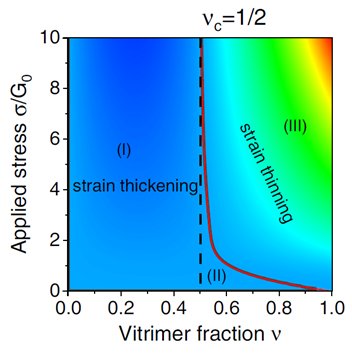Research Progress
Soft Matter Physics: Rheology of Vitrimers

Linear viscoelasticity. The response of vitrimers which are subjected to a small-amplitude oscillatory deformation, exhibits the same mathematical forms of storage modulus G’ and loss modulus G’’ with classical Maxwell model, where the characteristic time of vitrimers is defined by the inverse of the chain exchange reaction rate. When stretching the vitrimers with constant tensile forces, the materials will creep with constant velocities at the beginning (small deformation region), based on which we can define the viscosity of the materials; the linear viscosity is proportional the chain exchange rate.
Creep compliance. Vitrimers subjected to a constant tensile force exhibit the strain thinning response at large deformations, where the viscosity of the materials decreases with time. The reason of such strain thinnings in vitrimers is that the vitrimers lose the “mechanical memory” due to the chain exchange reactions.
Rheology of partial vitrimers. Partial vitrimers consist of two sub-networks, a vitrimer network allowing chain exchange reactions and a permanent network not allowing chain exchange reactions. In the linear viscoelastic regime, partial vitrimers respond as modelled by Zener model, and in the large deformation regime, partial vitrimers can exhibit strain thinning or strain thickening based on the volume fraction of vitrimer part, time and the mechanical stim

Fig 1: Rheological response of partial vitrimers in the short time limit.

Fig 2: Evolution of the response of a partial vitrimer with the volume fraction of vitrimer part as 0.8.
Link:
https://www.nature.com/articles/s41467-022-33321-w
Contact:
Institute of Theoretical Physics
Email:fanlong.meng@itp.ac.cn
